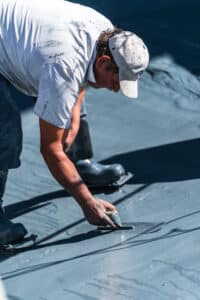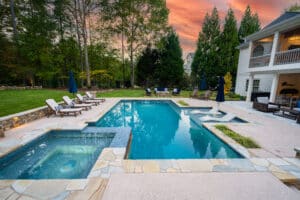Some people will give their pool builder free reign when designing their pool. I was not one of those people. I wanted to be involved in the design process from start to finish. This was my favorite part of the process and had me contemplating learning the Structure Studios software so that I could do freelance design work.
Here are some things to consider and decisions to make when designing a pool:
The first thing you’ll need to decide is what type of pool you’re going to design; concrete (aka. gunnite), fiberglass, or vinyl liner. Each has pros and cons, which have been discussed ad nauseum via a quick Google or YouTube search.

Elevation, slope, drainage, and the area’s natural terrain is probably the second most important factor to consider. An exposed beam/wall on the backside works well for a backyard that falls away from the house. If the yard slopes towards the house, a raised beam can be a good design option and act as a retaining wall. This can also be done if one side of the yard is higher than the other. A good pool builder knows how to build the pool/deck to the natural terrain.
Material selection makes a significant impact on the aesthetics of a pool. Therefore, materials should be considered simultaneously when the design is drawn up. This will ensure a cohesive theme in and around the pool.
Some pool builders don’t require homeowners to select materials until the build process is underway. I would discourage you from waiting that long to decide on materials, especially in today’s world of inflated prices, gas prices, and supposed shortages.
If you are in the planning or design phase, start making your material selections now. I’ll look at specific materials more in-depth in future blog posts, but below is a list of the standard selections that will need to be made when building a pool.
- coping material (cantilever, travertine, flagstone, marble, brick, etc.)
- deck material and color (pavers, brushed concrete, kool deck, stamped concrete, saw cut concrete, porcelain tile, etc.)
- interior finish (liner selection, fiberglass shell color, plaster, quartz, pebble, tile, etc.)
- waterline tile (if concrete or fiberglass)
- material for any raised or exposed walls
How do you envision you and your family using the pool?
The answer to this question will likely affect the design of the pool. If you have kids, you may want a deep-end and recreational feature for them. Examples include a jump rock, diving board, slide, or even a wall for jumping.
You may forego the deep end altogether if your pool is used more for sipping cocktails and having conversations. People spend most of their time in collections in the shallow end anyway. Features that work well for a pool like this include extra bench seating, an in-pool table or bar, and a tanning ledge with furniture.
 The shape of the pool is also an important decision and plays a big part in the flow of the backyard and the aesthetic you’re trying to achieve. The two main types of pools are free-form and geometric (rectangular and rectilinear).
The shape of the pool is also an important decision and plays a big part in the flow of the backyard and the aesthetic you’re trying to achieve. The two main types of pools are free-form and geometric (rectangular and rectilinear).
A free-form pool has a flowing shape that does not have hard angles/corners and produces a natural feel for the area. Free-form pools have come a long way since kidney-shaped collections first became popular in the 50s & 60s. In contrast, geometric pools use hard angles to create a more modern feel with sharper lines. Free form and geometric shapes can also be combined for truly original shapes.
One specific feature everyone should consider is a Tanning ledge. These are also sometimes called baja shelves or wet decks. These shallow areas (6″-18″ deep) are great for young kids and adults alike. Kids love playing on them, and many adults will purchase in-pool furniture to place on the ledge. A bubbler is a common feature found on tanning ledges, which helps with water movement. Bubblers also give children a small fountain to play with and create an excellent ambient sound when in use.
Water features can be found on many new pool builds. A few examples include sheer descents, rain descents, bubblers, scuppers, deck jets, and waterfalls.
Below are more elements some of the best pool builders add to their design.
Which features would you include in your dream pool?
- Infinity edge
- Zero Edge
- Perimeter overflow spa or pool
- Beach entry / Zero entry
- Rolled edges
- Floating pavers
- Lazy river
- Caves & grottos
- In-pool tables & bars
- Sunken fire pits and sitting areas
- Fire bowls & fire walls
- Acrylic pool wall
 This may seem like an overwhelming amount of information, but having as much knowledge as possible will help to make an informed decision. Many pool builders have limited design options because they never learned how to do more or don’t have the subcontractors to pull it off. Having an approximate design in mind or on paper when shopping for a pool builder will aid you in hiring someone who will be able to execute what you are looking for. We recommend looking for a builder who does 3D renderings for their clients as a part of the design process. In addition, recommend hiring a landscape architect to design the entire outdoor space before deciding on a pool builder.
This may seem like an overwhelming amount of information, but having as much knowledge as possible will help to make an informed decision. Many pool builders have limited design options because they never learned how to do more or don’t have the subcontractors to pull it off. Having an approximate design in mind or on paper when shopping for a pool builder will aid you in hiring someone who will be able to execute what you are looking for. We recommend looking for a builder who does 3D renderings for their clients as a part of the design process. In addition, recommend hiring a landscape architect to design the entire outdoor space before deciding on a pool builder.
Enjoy the process! Contact J&M Pool Company when you’re ready to start designing your pool.


